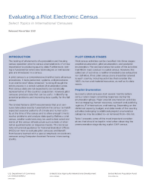
An official website of the United States government
Here’s how you know
Official websites use .gov
A .gov website belongs to an official government organization in the United States.
Secure .gov websites use HTTPS
A lock (
) or https:// means you’ve safely connected to the .gov website. Share sensitive information only on official, secure websites.
-
//
- Census.gov /
- Select Topics in International Censuses /
- Planning & Management /
- Evaluating a Pilot Electronic Census
Evaluating a Pilot Electronic Census
Evaluating a Pilot Electronic Census
Introduction
The testing of all elements of a population and housing census operation prior to census enumeration is of critical importance to producing quality data. Furthermore, testing is fundamental when new technologies or methodologies are introduced in a census.
A pilot census is a comprehensive trial that tests all census procedures. It tests personnel, systems, and procedures in an end-to-end “dress rehearsal,” running through the entire process in a select number of enumeration areas. Pilot census data are not expected to be statistically representative of the country’s population. However, pilot censuses produce data that can be useful in identifying potential problems and improving data quality for the full census.
The United Nations (2017) recommends that pilot censuses take place exactly 1 year before the census to match expected seasonal patterns of climate and human activity at the time of the census and to allow enough time to resolve problems and analyze data quality. Before a pilot census, smaller scale tests may be used to test select elements of the census infrastructure such as tests of alternative questionnaires or response modes. This technical note will provide guidance for National Statistical Offices (NSOs) on how to evaluate pilot censuses and benefit from lessons learned with a special emphasis on electronic censuses using Computer-Assisted Personal Interviewing (CAPI).
- This technical note is available in English, Russian, and Arabic.
Share
 Yes
Yes
 No
NoComments or suggestions?


Top


